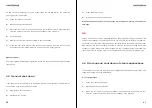
40
41
5.2.2 Chemical cleaning
A chemical cleaning company experienced in cleaning of plate heat exchangers is rec-
ommended.
The cleaning process should involve the use of common cleaning agent brands, which
normally contain additives that make for more effective cleaning and prevent corro-
sion. In order to achieve a good result, the cleaning agent should be chosen based on
the dirt and impurities in the process and/or heat exchanger.
The use of an unsuitable cleaning agent may result in worsening the impurity problem.
NB
¬ Before cleaning the heat exchanger with chemicals, check the resistance of all ma-
terials to that chemical.
¬ After chemical treatment, the plates must rinsed carefully with clean water.
¬ If, during cleaning on the coolant side, a high temperature occurs in the heat exchang-
er, ensure that the pressure on the refrigerant side does not exceed the design pres-
sure of the heat exchanger or the equipment connected to it. .
¬ Before cleaning, remove the refrigerant, and ensure that the refrigerant side is not
trapped.
Example of a procedure for cleaning the secondary side with chemicals:
1.
Close the valves 1.3 and 1.4. The temperature of the heat exchanger should be
between 10°C and 30°C.
2.
Connect the hoses of the chemical cleaning system to the valves 2.3 and 2.4.
3.
Fill the tank with the chemical solution.
4.
Switch on the pump (4) and let it run for 30–40 minutes. During cleaning, intermittent-
ly check the concentration and activity of the chemicals on the inlet and outlet side of
the heat exchanger. Stop cleaning when there is no longer any change.
5.
If dirt has been removed, drain the chemicals from the heat exchanger and the
tank, and neutralise the applied chemicals.
6.
Wash the plate surface with clean water using back flow.
7.
Put the heat exchanger back into normal operation, as described in section 4.
It may be necessary to clean the surface with chemicals more than once.
Handle chemicals and dirt in accordance with safety, environmental, governmental reg-
ulations and laws.
WARNING!
Before cleaning, check that the solution is suitable for the flow director material identi-
fied on the heat exchanger’s Techincal Data sheet.
5.2.3 Mechanical cleaning
It is possible to clean openable and EGE models mechanically with a high pressure
water jet using hot or cold water. Contact Vahterus for further information.

























